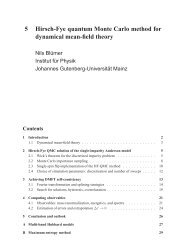Hubbard Model for Asymmetric Ultracold Fermionic ... - KOMET 337
Hubbard Model for Asymmetric Ultracold Fermionic ... - KOMET 337
Hubbard Model for Asymmetric Ultracold Fermionic ... - KOMET 337
You also want an ePaper? Increase the reach of your titles
YUMPU automatically turns print PDFs into web optimized ePapers that Google loves.
4.4. NUMERICAL RESULTS FOR THE GROUND STATE 41Thus the algorithm is very similar to the algorithm presented in Figure 3.11, where we presentthe way of solving (3.3) and (3.4) at fixed µ and ∆. Since µ appears only implicitly in theself-consistency equations, we decouple the Equations (3.3) and (3.4) at fixed n and use abisection method to solve (3.3) at fixed m and a successive iteration as in Figure 3.11 to solve(3.4). Afterwards we check if both equations are solved within the desired accurancy ǫ n andǫ m .The algorithm <strong>for</strong> solving the self-consistency equations uses scheme 4.4 and is presentedhere:Find µ and m at ∆ = 0Scan <strong>for</strong> sign changes in Res(∆)Sign change found?noTake ∆ = 0 as solutionyesUse combination of secant and bisection methodin order to solve (3.5) (as in algorithm 3.11)Compare Helmholtz free energy of the solutionsOutput of µ, m and ∆Figure 4.5: Solution algorithm <strong>for</strong> the self-consistency equations (3.3)-(3.5). algorithm 4.4 isused implicitly to obtain µ and m.With this procedure we are able to find the ground state of our spin-dependent hoppingHamiltonian at fixed occupation number n. We will now present results obtained with theuse of this method.4.4 Numerical results <strong>for</strong> the ground stateWe will now present the results of numerical calculations done according to algorithm 4.5.As hopping amplitude we have chosen t ↑ = 1 and t ↓ = 0.5. We calculate the parameters µ,m and ∆ as a function of U <strong>for</strong> different occupation numbers n.













